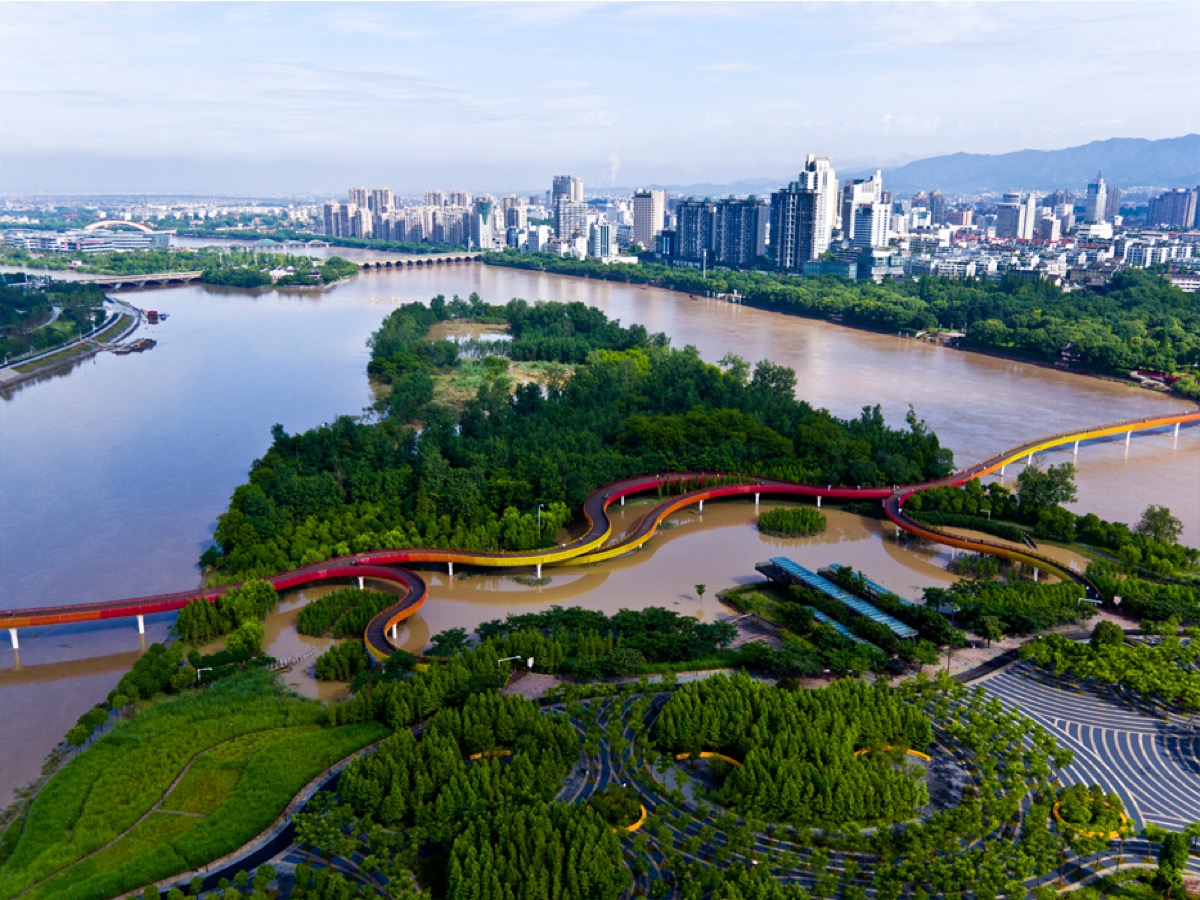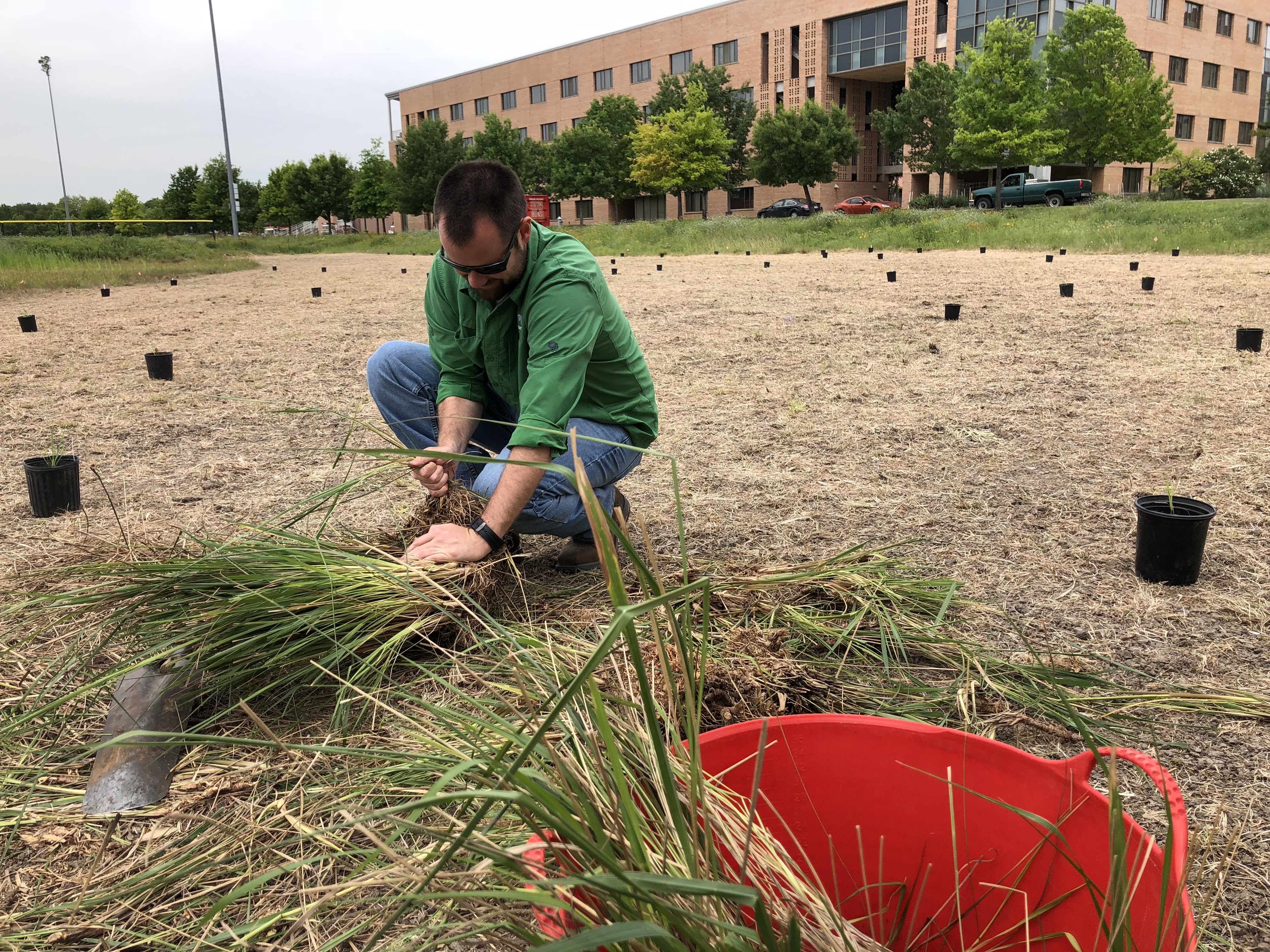Interview Highlights: Looking To Spongier Cities To Combat A Wetter Future
From “Sponge Cities” in China to small “pocket prairies” in Houston, cities are fortifying communities to better prepare for wetter environments.
 This story is part of Degrees Of Change, a series that explores the problem of climate change and how we as a planet are adapting to it. Tell us how you or your community are responding to climate change here.
This story is part of Degrees Of Change, a series that explores the problem of climate change and how we as a planet are adapting to it. Tell us how you or your community are responding to climate change here.
The future is looking wetter. The changing climate is bringing catastrophic floods, downpours, and other water issues that are becoming increasingly difficult to wrangle. Now, cities are looking past some of the more common means to block out or control water—such as dams, pipes, concrete channels—and instead are turning to nature to making their communities more resilient.
In the first installment of our new series, Degrees Of Change, we spoke to science journalist Erica Gies, urban flood risk management professor Chris Zevenbergen, and director of the Nature Conservancy Laura Huffman to learn about the water issues in China and Texas and what they are doing to solve them. Read highlights from the interview below.
The following responses have been edited for clarity and length. You can find the full segment transcript here.
On the water issues caused by current infrastructure.
Erica Gies: There are a lot of problems with the kind of gray infrastructure that we’ve used for the last couple hundred years—this effort to control water. The biggest one is that it breaks the natural water cycle. It cuts rivers off from their floodplains and it tends to increase water use, so a dam actually increases demand. So a lot of our “solutions” have counterintuitive problems associated with them. And urban sprawl is a big cause of both flooding and water shortages because it prevents water from being absorbed into the ground and going down into the aquifer like it would’ve done naturally.
On the green infrastructure that can help this problem.
Erica Gies: We’re starting to see this in cities around the world, like you mentioned green roofs. There are things called bioswales which are kind of lower elevation little gullies that are typically planted with water-loving plants. Pavement that’s permeable that water can pass through.
But a lot of it is looking at trying to see beneath our cities. We have creeks that have been put into sewers, and we have wetlands that have been filled with dirt and paved over. And the thing is the water still wants to go to these places. So the extent to which we can recover or reclaim or uncover these natural waterways can help a lot, because we are allowing water to do what it wants to do.
On water issues in China.
Erica Gies: China has a bunch of water problems, it has massive urban flooding. Between 2011 and 2014, 62% of its cities flooded. China has had this massive urbanization over the last few decades and they’ve sort of built their cities the way western development did, with all the same river channelization and pavement, and they’re seeing the problem with that.
And China, despite it getting a monsoon, is actually a pretty dry country, so water scarcity is a problem in more than half of its cities and more than 400 cities rely almost exclusively on groundwater, pumping groundwater, which also causes the land to sink. The urbanization has caused both a lot of flooding and water shortages. And of course, China also notoriously has a lot of pollution problems with water.
On China’s national Sponge Cities Program.
Erica Gies: The president, Xi Jinping, has made the environment one of his three pillars of government. When he learned about Sponge Cities he made it a national priority. In 2014, he initially made 16, and then 30 pilot cities, and their goal was to take a 10 acre area and capture 70% of the storm water that hits it.
Chris Zevenbergen: It’s a very comprehensive plan of President Xi to transform the cities into Sponge Cities. It goes a little bit beyond the installation of low impact development, which we have in the U.S.—rainwater systems, which control peak runoff and store rainwater.
It’s also about upgrading the traditional drainage systems to the standard level. It can also install or reintroduce the canals and waterbodies and multifunctional storage facilities. So it’s more concept than a technology.

On the mindset of building more water resilient infrastructure.
Kongjian Yu, principal designer of Turenscape’s Sponge Cities Project: It is changing, at least from the leadership. Gradually, we are changing the code system also, but that is taking a long time because of the interest conflict between the different groups of academia, of engineering, and of business. But at the same time many of the concrete walls have been removed from by some cities because the mayors understand and they know, and adapt to this idea. So we are, I think we are very promising.
On whether Sponge Cities can be adopted in other countries.
Erica Geis: I think they can. I think so far the projects in most other countries have been significantly smaller scale. But it’s not just smarter water management and less expensive, it can also be a climate mitigation solution. You know, wetlands store 40 times more CO2 than forests and both conservation of wetlands and forests are a key part of this nature-based water management and a recent report found that these natural climate solutions can actually help us meet 37% of the climate target for the Paris [Agreement] of keeping the world warming [below] 2 degrees [Celcius]. And yet they’re getting only 2.5% of public climate financing.
On Pocket Prairies.
Laura Huffman: So picture a pocket prairie as a very small-scale sponge, you were just talking about Sponge Cities in China. This can be your front yard, your backyard, it can be a vacant lot in a neighborhood, or a parking lot. And imagine you take all that concrete out and replace it with healthy soils and native plants. And in this case you then have a pocket prairie.
The way that these work is the root systems are so much deeper and more effective—picture channels underground and holes that absorb water. It would literally turn your front or backyard into a sponge.

On how effective pocket prairies are at dealing with water.
Laura Huffman: They could be pretty amazing neighborhood-level solutions to solving floodwaters. And one of the reasons we really like this movement in Houston is first of all it gives people something that they can do. Second of all, these [pocket prairies] will hold more water than the average lawn. The average lawn will retain about a half inch of water, and pocket prairies can hold as much as nine inches of rainfall. So they are better at absorbing and holding rainwater, they are local solutions, and they can scale up to a city-wide solution.
On how you can make a pocket prairie.
Laura Huffman: In this particular area in Houston, you’d be planting things like bluebonnets, wild indigo, sunflowers, native milkweed—which by the way, butterflies love. So not only will these pocket prairies help you with managing rainfall, they’re also wonderful for increasing urban biodiversity. And of course, one of the reasons we like it is because it allows people to connect to nature in their own neighborhoods.
There are lots of nurseries all over the state and all over the country that can help you understand what the native species are so you could turn your front and your backyard into whatever ecosystem happens to be appropriate for you live.
For those of you who don’t like mowing your lawn, this is a money solution. And if you do want to keep your lawn, we recommend you mow it less frequently and leave the clippings on the ground.
“The average lawn will retain about a half inch of water, and pocket prairies can hold as much as nine inches of rainfall.”
On how pocket prairies can help clean the water.
Laura Huffman: Those healthy nature soils and those native plants can help remove some of the pollutants which can be a really big problem when you’re experiencing a flood and you have all of the oil and pollutants associated with urban development. So they can be very effective little treatment plants.
On the state of the Texas legislature’s state flood recovery fund.
Laura Huffman: The bill is doing quite well. Really what this is recognizing is that we are going to experience more frequent and more intense storms because of climate change. And so how we rethink recovering from these disasters is essential and the thinking at the legislature is we’ve got to rebuild with resilience so that the next time this happens we are in better shape. And it’s everything from Pocket Prairies to great big regional open spaces and of course there is a role for traditional infrastructure, but I agree that even that could be smarter traditional infrastructure.
Invest in quality science journalism by making a donation to Science Friday.
Lauren J. Young was Science Friday’s digital producer. When she’s not shelving books as a library assistant, she’s adding to her impressive Pez dispenser collection.